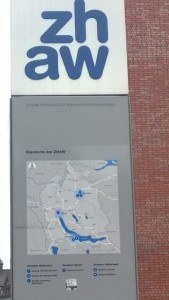Saara, Kara and Leila were here: AILA-Europe Junior Researchers Meeting in Winterthur Switzerland.

We were welcomed by Prof. Dr. Daniel Perrin, AILA Vice President. He gave us a short summary about the AILA activities worldwide. The opening words of conference were spoken by Prof. Dr. Urs Willi (Dean, School of Applied Linguistics, Switzerland).
The conference program consisted of four keynote presentations and 2 – 3 parallel sessions. The conference main thread was language use in digital settings, but the session papers discussed a wide range of topics related to applied linguistics.
Keynote presentations
After the opening speeches, Professor Troy Hicks (Central Michigan University, USA) gave the first keynote presentation entitled Teaching, Assessing and Revising Digital Writing. The key question was: How to get students to write? Prof. Hicks presented the main ideas of the recently published book “Assessing Students’ Digital Writing”. He summed up the benefits of digital tools with the following three claims: 1.While it may not directly improve test scores, digital writing leads to powerful learning. 2. With digital writing, the whole must be more than the sum of parts. 3. When assessing (and evaluating) we must account for both process and product. (Visit prof. Troy Hick’s website: http://hickstro.wikispaces.com and find his excellent notes from keynotes.)
The second conference day was initiated by Professor Christina Gitsaki’s (Zayed Univerisity Dubai, UAE) lecture: Mobile-Assisted Language Learning Research and Practice: Where to from here? She told us about the implementation of the digital/paperless learning and the related challenges at the Dubai University. The reform was carried out in a short time (approx. three months). The implementation succeeded, and after a transitional period, students used only iPads for learning, but the digitalization of teaching materials and curriculum could not keep up the pace. In practice, teachers scanned the old materials into the new media. Gitzaki also pointed out the need of revising assessment of learning outcomes: the traditional tests with paper and pencil (e.g. IELTS, which these students were required to take) do not measure the mobile-assisted language learning reliably.
On Saturday morning, Professor Wibke Weber (Zürich University of Applied Sciences, Switzerland) dealt with journalism in modern times in her presentation Fusing words and Images – new forms of public storytelling. One of the most fascinating graphic examples she introduced us was Nick Sousanis’s dissertation: http://spinweaveandcut.com/.
At last before the closing words, Professor Daniel Perrin (Zürich University of Applied Sciences, Switzerland) led us to the world of international communication: Investigating Intercultural communication on the digital workplace. His message was that intercultural communication does not only include communication between different nations but communication everywhere also, for example, at work between professions.
Session Papers
Many of the presentations were marred by too many presentation slides and/or too much text on these slides. Many presenters were enthusiastic about their research, but not always able to well communicate it in the allocated time. This highlighted the importance of considering the target audience when giving any type of presentation. In our opinions, our presentations were better structured and presented than those of the other participants, a view which was reflected in the positive feedback we received from our peers and senior researchers.
Two memorable presentations included “Digital literacy practices of Saudi students and the impact on writing in English as a second language” and “Language learning contexts (LLC) and the L2 selves of Spanish university students: The LLC and self-concept motivation questionnaire”. The former was of particular interest due to its focus on language samples taken from mobile applications such as Whatsapp. The latter presentation combined data from students learning English as second/foreign language in three specific contexts (Formal Instruction, Study Abroad & CLIL) in its analysis of L2 learner motivation.
AILA-Europe Junior Researcher Meeting in Applied Linguistics program can be read here
Text and photos: Saara Laakso, Kara Ronai and Leila Imppola, Ph.D. students , SOLKI

